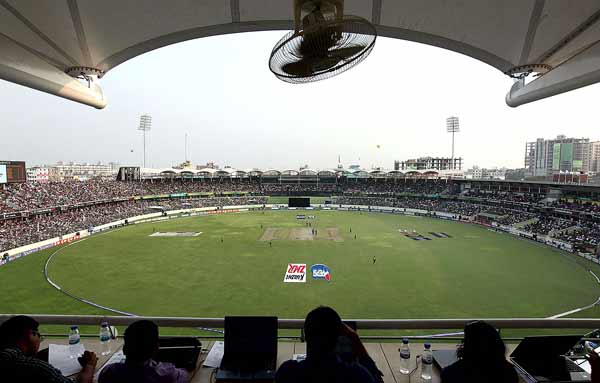Dhaka, Bangladesh (BBN)-Looking down at the Shere Bangla National Stadium from the high press box at the northern end of the ground is quite the experience.
The panoramic view can be mesmerizing- and often distracting when you are rushed to write a news piece or a match report and the deadline is looming, reports ESPNcricinfo.
Those who have played at the ground remark on how the noise levels go really high when the home team is doing well – whether that’s a Bangladeshi fielder fielding a ball cleanly or a home batsman hitting a match-winning six.
Of course, one wouldn’t expect a professional cricketer playing at the highest level to describe what it feels like playing in a particular stadium.
It is just another aspect of his or her job.
So a journalist keen to know has to use his imagination. Or, you know, actually experience playing there.
I had the opportunity to play at Bangladesh’s most celebrated cricket venue a number of years ago, in a match in the second tier of Dhaka’s first division league.
The game, which was played on the easternmost wicket, decided which team would be relegated and which stayed safe.
We won, and I’m happy to report I contributed to the cause.
The next opportunity came when the Bangladesh Sports Journalists Association was invited to play a T20 against a BCB XI comprising board directors, staff and former cricketers, in October this year.
Thankfully the weather held out and it was an experience of a lifetime – despite my numerous errors in the field, which brought howls of laughter from a surprisingly large audience.
We hoped to be able to bat under natural light, because all of us were first-timers under floodlights.
We thought it would be tricky batting at twilight, when the batsmen would have to deal with the onset of evening, before the floodlights had fully taken hold.
Turns out the BCB XI batsmen also had the same concerns. Many of them had not played under lights for quite some time.
Luckily for them, their captain, Akram Khan won the toss and decided to field first.
Despite our fears, our batting wasn’t all that bad in the waning light.
The wicket was true, with even bounce, and while the odd offbreak turned sharply, batting seemed as easy as it always does from the heights of the Mirpur press box.
So keen were our batsmen, in fact, that the moment the fourth wicket fell, the next one in line arrived at the wicket before the dismissed batsman could leave the 30-yard circle.
From the viewing area of the away dressing room, the structure of the grandstand seemed to swoop down on the players, especially those sitting beyond the rope.
By the time the floodlights took full effect, a sizeable crowd had gathered in the eastern galleries – about a thousand people, from among those who regularly turn up for any match or practice session at the ground as long as the lights are on.
These are mostly people who mill about near the stadium gates after work hours for a bit of street food and chat.
An informal game attracts them, as you usually don’t require a ticket to enter the stadium for these.
And since the eastern galleries were open, as they usually are, this friendly between the BCB and journalists found a decent crowd.
We were to defend 170-odd. Akram and Faruque Ahmed, another former Bangladesh captain and current chief selector, opened the innings for BCB.
The crowd warmed up as they started with a string of boundaries.
I soon realised that as captain, apart from rotating the bowlers, I also had to ensure we weren’t embarrassed.
I started to think about what it is like for an international cricketer to do this day in day out in front of large crowds.
Nothing goes unnoticed in front of so many people focused on watching 11 mostly overweight and generally out-of-shape players.
While some of the other outfielders slipped because they weren’t wearing spikes, I missed a clip through midwicket to which I should have moved a bit quicker.
The next chance I had was a skier that I lost in the lights, the ball landing ten feet to my left after I had initially placed myself under it.
Soon after, I missed a decently struck pull shot from Khaled Mahmud at midwicket, which scraped the top of my fingers as it went to the boundary.
There was a roar from the eastern galleries each time I made a fool of myself, while those sitting near the dressing room pulled out a few jibes about a cricket reporter not being able to take a catch.
Avoiding embarrassment wasn’t quite my forte, but a theatre like the Shere Bangla National Stadium doesn’t miss out on much, so when I cleanly fielded the ball, a large cheer went up.
I bowled lots of half-volleys and ended up with some unflattering figures next to a single wicket.
While bowling from the Mirpur Thana end, I glanced up at the press box up above and ahead a few times.
A Bangladesh player once said you could spot known faces in the press box from out in the middle.
I realised it is indeed possible- not that you’ll be doing much spotting, because you have bigger things to worry about in the field.
We lost with an over to spare, but it was an experience: the noise of the crowd, the beauty of the floodlights on the green grass, the hardness of the wicket, the surprising lack of turn, and the speed at which balls flew to the boundary.
More than all that, it renewed my appreciation of performers at the highest level.
Though I have played professional cricket at the club level in Dhaka, this game served as a useful reminder that a mistake in an international match does not always come down only to skills or their lack.
It takes nerves of steel at the top, and international cricket is for a different breed, regardless of however long one survives in it.
BBN/SK/AD

No Subscription? You Are Missing Out!
Join the business leaders of Bangladesh who rely on BBN's original reporting and in-depth analysis on business scenario of the country. We send only one daily email. No Spam Guaranteed!








